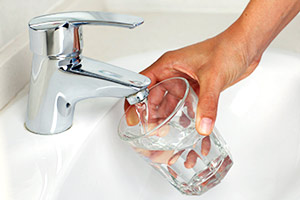F.A.Q. related to potable water and lead

How does lead occur in drinking water?
Lead seldom occurs naturally in water supplies like rivers and lakes. Lead enters drinking water primarily as a result of the corrosion, or wearing away, of materials containing lead in the water distribution system and household or building plumbing. These materials include lead-based solder used to join copper pipe, brass and chrome-plated brass faucets, and in some cases, pipes made of lead that connect houses and buildings to water mains.
In 1986, Congress banned the use of lead solder containing greater than 0.2% lead, and restricted the lead content of faucets, pipes and other plumbing materials to 8.0%. Older construction may still have plumbing that has the potential to contribute lead to drinking water.
Prior to 2014 the law allowed end-use brass fixtures, such as faucets, with up to 8% lead to be labeled as “lead free.” After 2014 this limit was lowered to 0.25%. Visit the National Sanitation Foundation Web site at www.nsf.org to learn more about lead-containing plumbing fixtures.
How do I learn about the quality of the water supplied to my house?
Public water systems are required to provide their users with Annual Water Quality Report (AWQR). If your water is supplied by a municipal supplier, contact them for this report. Lead and copper results for the most recent sampling can be found in this report. Community suppliers (not connected to municipal water systems) — those that supply water to at least 25 people in residences such as apartment buildings in rural areas — are also required to provide their users with an AWQR.
Annual Water Quality Reports (AWQR) may be found online for:
(link to external websites)
- Bolton Point Municipal Water System
- City of Ithaca Water District
- Cornell University Water Filtration Plant
How do I have the water tested at my house?
If you choose to test the water at your home, contact one of the laboratories on the Certified Water Testing Labs (pdf). They will provide information, sampling instructions and containers for proper testing. You may also call the Tompkins County Health Department for more information on testing at (607) 274-6688.
How can I reduce my exposure to lead that may be in the drinking water if I choose not to have the water tested in my home?
Run water for 15-30 seconds or until it becomes cold or reaches a steady temperature before using it for drinking or cooking, if it hasn’t been used for several hours. This reduces the concentration of lead-containing water from the pipes.
Do not cook with or drink water from the hot water tap; lead dissolves more easily into hot water. Do not use water from the hot water tap to make baby formula. Boiling water will not reduce lead concentration.
Additional Information Sources
EPA document: Lead in Your Drinking Water, Guidance for Home Owners (PDF, 165 KB)
EPA Website: Basic Information about Lead in Drinking Water
More about Water Systems: TCHD Water Systems Section
Related Documents
- Drinking Water Best Management Practices for Schools and Child Care Facilities With Their Own Drinking Water Source. US-EPA, April 2013. 24 pages. (PDF, 843KB)
- Lead and Copper Rule: A Quick Reference Guide for schools and child care facilities that are regulated under the safe drinking water act. US-EPA. 5 pages. (PDF, 369KB)
- 3Ts for Reducing Lead in Drinking Water in Schools. Revised Technical Guidance. US-EPA. 104 pages. (PDF, 1.77MB)
- Certified Water Testing Labs (PDF)

